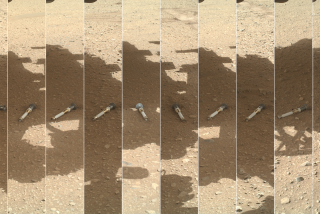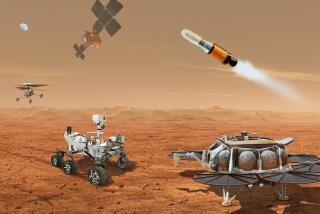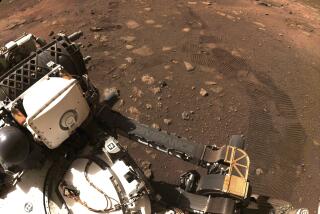A Mars rover built to leave others in the dust
Wider than a Hummer, tall enough to roll over boulders and toting a laser “ray gun” that can zap rocks at 30 feet, NASA’s next-generation Mars rover looks like something you would paint a skull and crossbones on and enter in a demolition derby.
Compared to Sojourner, the dowdy little robot that tooled around on Mars for three months in 1997, the atomic-powered Mars Science Laboratory rover being built at the Jet Propulsion Laboratory in La Canada Flintridge is an interplanetary beast.
“Nothing like this has ever been sent to Mars before,” said Joy Crisp, 49, deputy project scientist for the new mission.
But then, this new rover has a big job: settling once and for all whether the conditions on ancient Mars were suitable for life.
With a full complement of the most sophisticated instruments in NASA’s tool chest, and the ability to drive over obstacles that deterred earlier rovers, the Mars Science Laboratory, or MSL, will strip away billions of years of Martian history to reveal its watery childhood and, possibly, evidence of any microbes that swam in those ancient seas.
The challenge is getting it there -- and getting it there on time.
Landing an oversized rover on a far-off planet, while facing a drop-dead launch date in fall 2009, is daunting enough to worry even experienced engineers.
“This is a study in managed paranoia,” said Adam Steltzner, 44, who heads the 25-member team responsible for the landing phase of the mission.
Because the rover is so large, it can’t be bundled up in air bags that bounce along the surface before opening, as was done with the rovers Spirit and Opportunity. Instead, Steltzner and his team have come up with a landing system he compares to a Rube Goldberg contraption.
The rover, like a piano being lowered from an upper-floor apartment, will be dropped on ropes from a hovering spacecraft called a sky crane.
“Our system looks crazy,” Steltzner said. “But it’s intrinsically safe.”
Fascination with Mars’ ability to support life goes back hundreds of years to the time when early astronomers imagined alien boatmen plying its canals.
So excitement was high when the twin Viking missions landed on the planet in 1976.
No signs of life were found. “Self-sterilizing” is the term scientists used to describe a place that appeared more barren than the harshest wastelands on Earth.
The disappointment set back Mars research for a generation. NASA didn’t return until the 1990s, when it began trying to unravel the planet’s geology and history with new and more sophisticated instruments.
Sojourner came first, clearing the way for Spirit and Opportunity, which landed in 2004.
The two rovers carry several spectrometers and a RAT -- or rock abrasion tool -- which they’ve used to analyze the mineral makeup of Martian rocks. The rovers’ marquee discovery was that a shallow sea once covered portions of the planet’s surface.
The next craft to visit Mars will be NASA’s Phoenix lander, which is scheduled to touch down near the north pole this summer to analyze the large quantities of ice that have been detected just beneath the planet’s surface.
But the most ambitious mission is MSL, which has the broadest possible mandate: to find out whether Mars was, or might still be, habitable for rudimentary life forms.
It also will assess the potential for human settlement, on the assumption that future presidents will carry through on President Bush’s plan to send astronauts to Mars this century.
Doing all this requires what Crisp called a “souped-up rover.”
On first glance, MSL has the vaguely insect-like look of Spirit and Opportunity: a flat, spider-like body with a mast at the front containing cameras to help the rover plot its course across the planet’s surface.
But there are important differences. The 43-inch-high main deck, where the instruments are located, will allow MSL to roll right over rocks that would frustrate Spirit and Opportunity.
Solar panels cover the decks of the smaller rovers. But MSL needs more power for its hungry instrument package than the sun can deliver, particularly in Martian winter, when the sun is little more than a bright dot on the horizon.
MSL is taking its power source with it in the form of a radioisotope thermoelectric generator. The RTG carries 10.6 pounds of plutonium dioxide, which produces heat that is converted into electricity. The mission is scheduled to last one Martian year, which is equal to about two Earth years, although the RTG will be able to supply power for many years.
Like Spirit and Opportunity, MSL carries a drill to bore into interesting rocks. But unlike the smaller rovers, MSL will capture the powder from the drill holes and send them to two onboard instruments for chemical analysis.
The CheMin instrument will bombard the powder with X-rays to determine its mineral composition. An instrument called SAM, for sample analysis at Mars, will cook the powder, looking for organic compounds, which boil off at low temperatures.
Those compounds include carbon, hydrogen, nitrogen, oxygen, phosphorous and sulfur, the essential building blocks of life.
MSL will also try to identify the effects of biological processes, such as grains in the rocks that could have been made by bacteria.
“We’ll have to put a lot of clues together,” Crisp said. “If we get incredibly lucky, we might even see a fossil.”
Spirit and Opportunity spent a lot of time grinding holes in rocks that turned out to be not that interesting. MSL can short-circuit that time-consuming process with a high-intensity laser, which can vaporize a spot on the surface from a distance of 30 feet. The closest thing to a science-fiction-style ray gun, the target will give off a gaseous plasma that an instrument called the ChemCam can quickly scan before deciding whether to go in for a closer look.
If there ever was a living creature on Mars, ChemCam, CheMin and SAM will have the best chance yet of finding its chemical signature, the scientific team says.
“This is the most capable payload we’ve ever sent anywhere,” said mission manager Mike Watkins.
NASA has narrowed the list of landing sites from dozens to six, several of which are known to contain phyllosilicates, which are a class of minerals that contain water, Crisp said.
The Eberswalde Delta has the fan-shaped signature of deltas on Earth, which are formed by the movement of water over millennia. Holden Crater has richly layered rocks and steep cliffs. One landing site, known as North Meridiani, which is like the plains where Spirit and Opportunity have been operating since 2004, was chosen for its safety.
No matter how safe the landing site, the mission’s success depends on Steltzner and his team’s ability to deliver the rover intact.
The sky crane concept “is the most obviously complex system we’ve ever tried,” Steltzner said. “But it’s not as risky as it sounds.”
Air bags, despite their successful use with Spirit and Opportunity, have an inherently unsafe -- pathological, Steltzner said -- interaction with the surface of the planet.
The sky crane doesn’t depend on sensors. It will know the rover has touched down because the Kevlar ropes will suddenly go slack.
The descent craft, with the MSL folded up, will enter the thin Martian atmosphere in a shell-like package.
At about 10 miles above the surface, a parachute will open, slowing the craft to about 200 mph.
At a mile above the surface, the parachute will fall away and eight descent engines will fire. About 70 feet above the ground, the craft begins lowering the 1,900-pound rover, similar to the way climbers rappel down mountains.
When the rover touches the surface, the descent craft will cut loose and fly off a short distance to avoid crashing into the rover.
Every landing on a planet is terrifying, said Steltzner, whose team also programmed the landings of Spirit and Opportunity. But the sky crane is fraught with opportunities to damage or destroy the rover, Steltzner said.
“I spend quite a few hours every day thinking about it,” he said.
Getting the landing right isn’t the only problem the team faces. There’s some concern about getting the mission ready in time for the launch, scheduled for between Sept. 15 and Oct. 8, 2009. If the launch team misses the deadline, it will be two years before the planets align for another attempt.
Cost is another worry. At $1.8 billion, the mission’s cost amounts to about 10% of the agency’s annual budget.
“It’s burning a million dollars a day, every day,” said James Green, head of NASA’s planetary division.
All that money has brought high expectations -- and plenty of anxiety from Washington.
Last fall, NASA ordered the Jet Propulsion Laboratory to remove some of the rover’s instrumentation to save money. The heat shield also had to be redesigned, running up costs.
Testifying before a House science committee last month, NASA Administrator Michael Griffin said the project had gone slower than he would have liked.
But he said he didn’t consider the problems to be out of the ordinary for such a complex project.
Green said NASA remained committed to the effort.
“We had to compromise on some things,” said Watkins, the mission manager. “But we still have a fantastic mission.”
More to Read
Sign up for Essential California
The most important California stories and recommendations in your inbox every morning.
You may occasionally receive promotional content from the Los Angeles Times.










